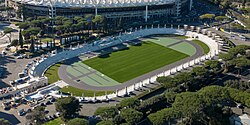| Stadio dei Marmi | |
|---|---|
 Stadio dei Marmi (erected in 1932), Foro Italico, Rome, Italy | |
 Click on the map for a fullscreen view | |
| General information | |
| Location | Rome |
| Coordinates | 41°56′03″N 12°27′27″E / 41.934290°N 12.457380°E |


The Stadio dei Marmi ("Stadium of the Marbles") is one of four stadiums in the colossal sports complex the Foro Italico, initially named Foro Mussolini.[1] The other stadiums are the Stadio Olimpico, the Stadio del tennis Romano, and the Stadio Olimpico del Nuoto.[2] It was designed in the 1920s as a complement to the annexed Fascist Academy of Physical Education (now the seat of CONI, Italian Olympic Committee), to be used by its students for training.[3] The Stadio dei Marmi first opened in 1932, on the 10th anniversary of the March on Rome, near the Roman neighborhood Monte Mario, by the architect Enrico Del Debbio under the Fascist ruler Benito Mussolini.[1] The Stadio dei Marmi is encircled by sixty, 4-meter tall classical statues of athletes made from Carrara marble.[2] The stadium was built to celebrate Fascist accomplishments and the Gioventú del Littorio, the youth movement of the National Fascist Party of Italy.[1] In its twenty-year reign, the Fascist regime used sports to introduce and instill new fascist traditions, ideals, customs, and values, with the goal of forming citizen warriors.[4] The Stadio dei Marmi was used to host some of the field hockey preliminaries for the 1960 Summer Olympics and also hosted the opening ceremony for the 2009 World Aquatics Championships.
- ^ a b c Giorio, Maria Beatrice. “La Scultura Fascista Di Soggetto Sportivo Tra Bellezza e Propaganda Ideologica.” Italies, no. 23, 2019, pp. 68., doi:10.4000/italies.6979
- ^ a b Dyal, Mark. "Football, Romanità, and The Search For Stasis." In Global Rome: Changing Faces of the Eternal City, edited by Marinaro Isabella Clough and Thomassen Bjørn, 175. Indiana University Press, 2014. Accessed March 4, 2021. http://www.jstor.org/stable/j.ctt16gzp33.15 .
- ^ Baxa, Paul. 2010. Roads and Ruins: The Symbolic Landscape of Fascist Rome. Toronto: University of Toronto Press. BAXA, PAUL. "Demolitions: De-familiarizing the Roman Cityscape." In Roads and Ruins: The Symbolic Landscape of Fascist Rome, 73. University of Toronto Press, 2010. Accessed March 30, 2021. http://www.jstor.org/stable/10.3138/9781442697379.8 .
- ^ Falasca-Zamponi, Simonetta. “Fascist Spectacle: The Aesthetics of Power in Mussolini's Italy.” Berkeley: University of California Press, 1997, p. 90., doi:10.1525/9780520926158